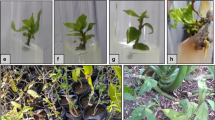Abstract
An efficient protocol for in vitro propagation of the valuable ornamental and medicinal plant Bush germander (Teucrium fruticans L.) was developed through axillary shoot proliferation. A Murashige and Skoog agar medium supplemented with benzylaminopurine (6.6 μM), α-naphthaleneacetic acid (0.053 μM), and sucrose (3%) significantly improved the production of multiple shoots directly from nodal segment explants, resulting in an average of 2.8 shoots per segment with an average of 6.8 nodes per shoot that would be potential newly formed explants. The new shoots were developed without a marked decrease in the average height of the shoots. Shoots treated with 2.5 μM indole-3-butyric acid showed the highest average root number (7.9) and the highest percentage of rooting (94%). Plantlets were hardened off and transferred to jiffy pots for acclimatization under greenhouse conditions, resulting in a 100% survival rate.

Similar content being viewed by others
References
Ahuja M. R. Micropropagation of Woody Plants. Kluwer Academic, Dordrecht 1993.
Brassard N.; Brissette L.; Lord D.; Laliberte S. Elongation, rooting and acclimatization of micropropagated shoots from mature material of hybrid larch. Plant Cell Tiss. Organ Cult. 44: 37–44; 1996. doi:10.1007/BF00045911.
Bruno M.; Ciriminna R.; Piozzi F.; Rosselli S.; Simmonds M. S. J. Antifeedant activity of neo-clerodane diterpenoids from Teucrium fruticans and derivatives of fruticolone. Phytochemistry. 52: 1055–1058; 1999. doi:10.1016/S0031-9422(99)00385-4.
Cline M. G.; Harrington C. A. Apical dominance and apical control in multiple flushing of temperate woody species. Can. J. For. Res. 37: 74–83; 2007. doi:10.1139/X06-218.
Coll J.; Tandrón Y. Neo-clerodane diterpenes from Teucrium fruticans. Phytochemistry. 65: 387–392; 2004. doi:10.1016/j.phytochem.2003.09.018.
Dizengremel M. N.; Foucard J. C.; Bigot C. Expériences préliminaires sur la multiplication in vitro de quelques espèces destinées au remplacement de Pomoïdées ornementales sensibles au feu bactérien = Preliminary experiments on in vitro propagation of some species destinated to replacement of fine blight sensitive ornamental Pomoideae. PHM, Revue horticole. 246: 13–23; 1986.
Flamini G.; Cioni P. L.; Morelli I.; Maccioni S.; Monti G. Composition of the essential oil of Teucrium fruticans L. from the Maremma Regional Park (Tuscany, Italy). Flavour and Fragrance J. 16: 367–369; 2001. doi:10.1002/ffj.1014.
Fontana G.; Savona G.; Rodríguez B.; De la Torre M. C. Unusual 6′-fatty acid esters of (24S)-24-ethylcholesta-5,25-dien-3β-yl β-glucopyranoside from Teucrium fruticans. Phytochemistry. 50: 283–285; 1999. doi:10.1016/S0031-9422(98)00511-1.
Frangi P.; Nicola S. Study of propagation by cutting of Mediterranean native species with ornamental potential. Italus Hortus (SOI). 11: 191–193; 2004.
Geneve R. L.; Kester S. T. Polyamines and Adventitious Root Formation in the Juvenile and Mature Phase of English Ivy. J. Exp. Bot. 42: 71–75; 1991. doi:10.1093/jxb/42.1.71.
Kisiel W.; Stojakowska A.; Piozzi F.; Rosselli S. Flavonoids from Teucrium fruticans L. Acta Soc. Bot. Pol. 70: 199–201; 2001.
Le Guen-Le Saos F.; Hourmant A. Stimulation of putrescine biosynthesis pathway by gibberellic acid in the (Cynara scolymus). Plant Growth Regul. 35: 277–284; 2001. doi:10.1023/A:1014494013416.
López J.; González A.; Fernández J. A.; Bañón S. Ornamental use of labiates for xeriscape in Mediterranean area. Acta Hortic. 723: 459–464; 2006.
Maccioni S.; Guazzi E.; Tomei P. E. Le piante nella medicina popolare del Grossetano. I. Le colline fra l’Ombrone e l’Albegna. Atti del Museo di Storia Naturale della Maremma, Grosseto, Italy. 16: 25–46; 1997.
Makunga N. P.; Jäger A. K.; Van Staden J. Micropropagation of Thapsia garganica—a medicinal plant. Plant Cell Rep. 21: 967–973; 2003. doi:10.1007/s00299-003-0623-8.
Mendoza-de Gyves E.; Royani J. I.; Rugini E. Efficient method of micropropagation and in vitro rooting of teak (Tectona grandis L.) focusing on large-scale industrial plantations. Ann Forest Sci. 64: 73–78; 2007. doi:10.1051/forest:2006090.
Murashige T.; Skoog F. A revised medium for rapid growth and bioassays with tobacco tissue cultures. Physiol. Plant. 15: 473–497; 1962. doi:10.1111/j.1399-3054.1962.tb08052.x.
Nalawade S. M.; Sagare A. P.; Lee C. Y.; Kao C. L.; Tsay H. S. Studies on tissue culture of Chinese medicinal plant resources in Taiwan and their sustainable utilization. Bot. Bull. Acad. Sin. 44: 79–98; 2003.
Ojeda F.; Díez M. J. Pollen dimorphism in threeTeucrium species (Lamiaceae). Plant Systematics and Evol. 183: 43–49; 1992. doi:10.1007/BF00937734.
Okemo P. O.; Bais H. P.; Vivanco J. M.; In vitro activities of Maesa lanceolata extracts against fungal plant pathogens. Fitoterapia. 74: 312–316; 2003. doi:10.1016/S0367-326X(03)00039-X.
Osuna L.; Tapia-Pérez M. E.; Figueroa O.; Jiménez-Ferrer E.; Garduño-Ramírez M. L.; González-Garza M. T.; Carranza-Rosales P.; Cruz-Vega D. E. Micropropagation of Lepidium virginicum (Brassicaceae), a plant with antiprotozoal activity. In Vitro Cell Develop. Biol. Plant. 42: 596–600; 2006. doi:10.1079/IVP2006826.
Parveen; Sharma V. K.; Mandal A. K. A protocol for micropropagation of an important medicinal plant—Oroxylum indicum Vent. through cotyledonary nodal explants. Ann Forestry. 13: 53–58; 2005.
Rugini E. In vitro propagation of some olive (Olea europaea L.) cultivars with different root-ability and medium development using analytical data from developing shoots and embryos. Sci Horticult. 24: 123–134; 1984. doi:10.1016/0304-4238(84)90143-2.
Rugini E.; Wang X. S. Effect of Polyamines, 5-azacytidine and Growth Regulators on rooting in vitro of fruit trees, treated and untreated with Agrobacterium rhizogenes. In: Proceedings of the International Congress of Plant Tissue and Cell Culture. Minnesota, August 3–8, p 374; 1986.
Savona G.; Passannanti S.; Paternostro M. P.; Piozzi F.; Hanson J. R.; Hitchock P. B.; Siverns M. Two new diterpenoids from Teucrium fruticans. J. Chem. Soc. Perkin Transactions 1:356–359; 1978.
Van Twembeke E.; Geelen D. Micropropagation of the medicinal plant Maesa lanceolata Forssk. Commun Agric. Appl. Biol. Sci. 71: 311–313; 2006.
Author information
Authors and Affiliations
Corresponding author
Additional information
Editor: N.J. Taylor
Rights and permissions
About this article
Cite this article
Frabetti, M., Gutiérrez-Pesce, P., Mendoza-de Gyves, E. et al. Micropropagation of Teucrium fruticans L., an ornamental and medicinal plant. In Vitro Cell.Dev.Biol.-Plant 45, 129–134 (2009). https://doi.org/10.1007/s11627-009-9192-z
Received:
Accepted:
Published:
Issue Date:
DOI: https://doi.org/10.1007/s11627-009-9192-z




